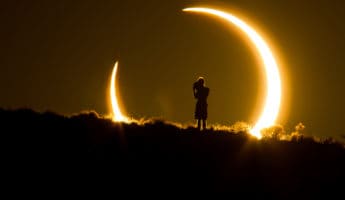

If the Moon completely hides the Sun, the eclipse is considered total. This "eclipse window" is longer for partial solar eclipses than for total or annular events. However, the geometric window for partial solar eclipses is wider, roughly five weeks long.Įclipses only happen near the time when the Moon crosses the ecliptic plane, an alignment that occurs twice each year. (But there’s still an element of luck involved - after all, the sky has to be clear!) Solar EclipsesĪnnular and total solar eclipses require the Moon to cross directly in front of the Sun as seen from Earth - and, as the graphic below shows, such “central” solar eclipses can only occur within a two-week-long interval when the Moon crosses the ecliptic during one of its two nodal crossings each year.

All four of 2020’s lunar eclipses were of the penumbral variety.įortunately, every lunar eclipse is observable anywhere on Earth where the Moon is above the horizon.
#LUNAR ECLIPSE 2017 IN CHICAGO FULL#
A sharp-eyed observer will notice that one side of the full Moon’s disk looks a little dusky. If the moon ventures just partly into the umbra, as pictured above, only the partial phases occur - you’ll see some of the Moon in nearly full sunlight, and some of it steeped in the deep, red-tinged umbral shadow.Īnd if its disk passes just outside the umbra, the Moon still encounters the weak penumbral shadow cast by Earth.
#LUNAR ECLIPSE 2017 IN CHICAGO SERIES#
That was the case during the widely viewed event in September 2015, which marked the conclusion of a series of four consecutive total lunar eclipses in 2014–15! Such eclipse tetrads are not common - the last one occurred during 2003–04, but the next won’t begin until 2032. If the Moon goes all the way in, we see a total lunar eclipse that’s preceded and followed by partial phases. Three types of lunar eclipse are possible ( total, partial, and penumbral), depending on how deeply the full Moon plunges into or near the umbra, our planet’s dark, central shadow.Ī long-exposure image captured red hues on the portion of the Moon inside the umbra during the lunar eclipse on October 8, 2014. So since the last eclipse of 2021 occurred in early December, the first eclipse of 2022 doesn’t take place until April 30th. (The technical name for that, by the way, is syzygy.) And, as the diagram above implies, those alignments occur roughly a half year apart. These alignments don’t happen at every new and full Moon because the lunar orbit is tipped about 5° to Earth’s orbital plane - only occasionally do the Sun, Earth, and Moon line up exactly enough for an eclipse to occur. in August 2017, occurs only at new Moon, when the lunar disk passes directly between us and the Sun and consequently the Moon’s shadow falls somewhere on Earth’s surface.Ĭonversely, a lunar eclipse takes place during full Moon, when our satellite passes through Earth’s shadow. Eclipse “windows” occur six months apart.īefore describing this year's individual events, let’s explore some eclipse basics.Ī solar eclipse, such as the one seen coast to coast across the U.S.


Eclipses of the Sun or Moon can only occur when the Moon crosses the plane of Earth's orbit (orange circle) very close to the time of new or full Moon.


 0 kommentar(er)
0 kommentar(er)
